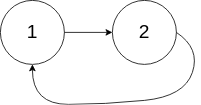给定一个链表,返回链表开始入环的第一个节点。 如果链表无环,则返回 null。
为了表示给定链表中的环,我们使用整数 pos 来表示链表尾连接到链表中的位置(索引从 0 开始)。 如果 pos 是 -1,则在该链表中没有环。
说明:不允许修改给定的链表。
示例 1:
输入:head = [3,2,0,-4], pos = 1
输出:tail connects to node index 1
解释:链表中有一个环,其尾部连接到第二个节点。
示例 2:
输入:head = [1,2], pos = 0
输出:tail connects to node index 0
解释:链表中有一个环,其尾部连接到第一个节点。
示例 3:
输入:head = [1], pos = -1
输出:no cycle
解释:链表中没有环。
进阶: 你是否可以不用额外空间解决此题?
Solution1
利用Hash表
/**
* Definition for singly-linked list.
* class ListNode {
* int val;
* ListNode next;
* ListNode(int x) {
* val = x;
* next = null;
* }
* }
*/
public class Solution {
public ListNode detectCycle(ListNode head) {
Set<ListNode> set = new HashSet<>();
while (head != null) {
if (set.contains(head)) return head;
set.add(head);
head = head.next;
}
return null;
}
}复杂度分析:
- 时间复杂度 O(N)
- 空间复杂度 O(N)
Solution2
/**
* Definition for singly-linked list.
* class ListNode {
* int val;
* ListNode next;
* ListNode(int x) {
* val = x;
* next = null;
* }
* }
*/
public class Solution {
public ListNode detectCycle(ListNode head) {
if(head == null || head.next == null) return null;
ListNode slow = head.next, fast = head.next.next;
while (fast != null && fast.next != null) {
if (fast == slow){
//第一次相遇
fast = head;
//再次相遇即为起点
while(fast != slow) {
fast = fast.next;
slow = slow.next;
}
return slow;
}
slow = slow.next;
fast = fast.next.next;
}
return null;
}
}复杂度分析:
- 时间复杂度 O(N)
- 空间复杂度 O(1)
hash法:https://leetcode-cn.com/problems/linked-list-cycle-ii/solution/huan-xing-lian-biao-ii-by-leetcode/


